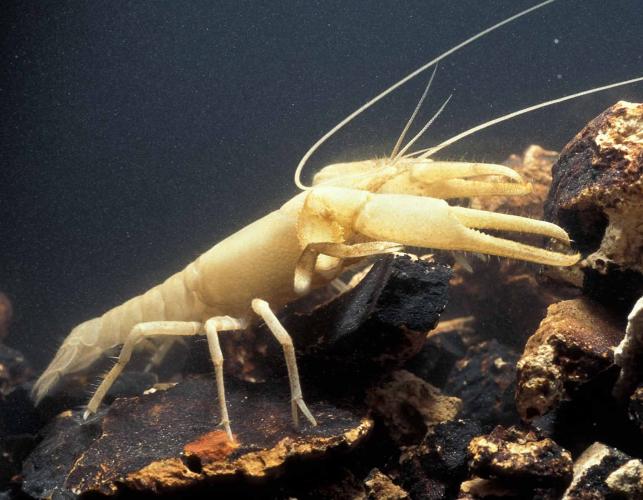
The bristly cave crayfish is a whitish crayfish with small, unpigmented eyes and long, slender pincers with noticeable setae (bristles). The rostrum (triangular area between the eyes) has a central, troughlike depression, and its margins narrow rather abruptly into the rather short tip. When newly molted, this crayfish is nearly white; otherwise, it is off-white or reddish white, particularly on the abdomen. Smaller individuals are nearly translucent. The areola (hourglass-shaped area down the midline of the carapace) is small or absent.
Similar species: The Salem cave crayfish has an areola; the rostrum has a long, slender tip; the setae on its pincers are short and hard to see; and it does not occur in the same caves (it occurs in the east-central Ozarks). The Caney Mountain cave crayfish is not found in the same cave systems as the others.
Adult length: about 2¼ to 3¾ inches (males larger than females).

Occurs in 9 counties in southwestern Missouri’s Springfield Plateau section of the Ozarks, where it has been found 3 major stream systems: Neosho (Elk and Spring), White, and Missouri (Osage). It has also been found in extreme northeastern Oklahoma and nearby Arkansas.
Habitat and Conservation
One of at least 3 species of cave crayfish in Missouri, the bristly cave crayfish has been collected from areas of complete darkness as well as from the twilight zone of caves, from the outflow of springs, and from shallow wells exposed to daylight. It’s been found on substrates of sand and silt, sometimes scattered rock, as well as near the guano piles of roosting bats. So far, this cave crayfish has not been found in the same caves as other species of cave crayfish.
Food
The bristles on the bristly cave crayfish enhance its sense of touch in the complete dark of caves, helping it detect food. Crayfish are generally omnivores, eating a wide variety of plant and animal materials. Because green plants are rather scarce inside caves, this species undoubtedly eats a larger proportion of animal material (as a predator of live animals, or a scavenger of dead ones) than other crayfish.
Status
A species of conservation concern in Missouri. Populations seem to be secure, but this crayfish’s limited range and habitat restrictions make it a species that is vulnerable to extinction. Agricultural and other chemicals, and silt from surface excavation, can enter the ground water and pollute the streams in the caves where these crayfish live.
Life Cycle
Little is known of the life history of this species. Males in breeding condition have been collected in all seasons of the year. Mating activity as well as a female carrying eggs have been observed in June, and a very young individual has been discovered in December.
Human Connections
For our own sake, and for these and other cave animals to survive, humans must curb activities that pollute the water underground. Additionally, humans must refrain from entering, littering, or otherwise disturbing the delicate ecosystems therein.
Ecosystem Connections
Crayfish eat a variety of materials, including living and dead animal life, and this cave crayfish undoubtedly feeds on cave isopods and other animals that live in the streams of caves. Crayfish, living or dead, are in turn an important food for many other animals.








































